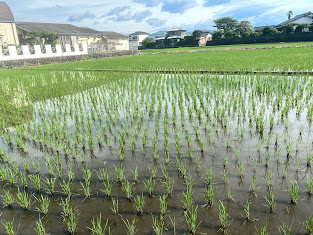I have always been extremely interested in mythology and folklore. It started in my teens where I started reading about European mythology (Norse, Celtic, Greek and Roman). This interest continued to my university years where I picked Celtic civilisation as my minor subject in my degree.
Living in Ireland I did not have any exposure to Japanese
mythology and folklore. Since coming here I’m eager to learn what I can. I have
decided to make a series of blog posts about this topic.
I am by no means an expert in this topic but I will do my
best to share the knowledge I have learned and share my observations from a
western perspective. In this blog post I will introduce the art form of Kagura
and I will share a famous tale that is often re-enacted in Kagura performances.
Kagura
The first glimpse I had into Japanese mythology and folklore was when I went to Kagura festivals in early autumn 2019. Kagura is a sacred Japanese dance normally performed at Shinto shrines across Japan especially in spring and autumn seasons. The dance is accompanied by music played by a wooden flute and a large drum.
It is rare to find Kagura in urban areas, generally the
performances are in the countryside which means most tourists visiting japan
will not be exposed to it. Shimane prefecture and Kyushu are probably the most
famous places you can see Kagura performances in Japan
Some performances re-enact epic tales about the Kami
(Japanese gods) defeating demons or beasts. Most of these stories come from an
8th century text called the Kojiki. The performers wear elaborate
costumes and masks which are made locally by experts in the community.
Susanno – The slaying of Yamata no Orochi
One of the most famous stories I have seen being retold in Kagura
performances features a Kami called Susanno. In this story Susanno meets a
distressed elderly couple. The couple explain that 7 of their 8 daughters have
been sacrificed to a monstrous serpent and they fear that they will also lose
their last daughter.
A woodblock painting of Susanno slaying Orochi by Toyohara Chikanobu
The serpent they speak of is called Yamata no Orochi. This
serpent is said to have 8 heads, 8 tails and bloody red eyes. Its body was said to be large enough to cover 8 valleys, it also had moss and cedar trees that grew upon it.
Susanno promises to defeat the serpent but in return
requests the last daughter’s hand in marriage if he succeeds. The family
agrees, Susanno turns the daughter into a hair comb and places it into his hair
to keep the daughter protected. Susanno then requests that the family prepare
the strongest sake they can make and to divide it into 8 large barrels.
The sake is prepared and left out for Orochi, and villagers hide and wait for him to arrive. Sure enough the serpent arrives and is delighted to see the sake left out. The serpent drinks the sake, becomes very drunk and eventually falls asleep. Susanno takes this opportunity to attack and chops the beast into pieces. In doing this Susanno finds a legendary sword inside its tail. This sword "Kusanagi-no-Tsurugi" later becomes one of the 3 treasures of the Imperial Regalia of Japan. After Orochi is slain, Susanno returns the daughter to her human form and marries the maiden as agreed.
My observations of the story
This is one of my favourite examples of heroic literature.
The story has some similarities to the Greek tale of Perseus and Medusa. In
this tale, Medusa is a monstrous gorgon who has live snakes on her head. She is
described as having piercing eyes that can turn you into stone if you look into them.
Perseus defeats Medusa in exchange for the marriage of the maiden in distress.
Additionally Perseus does not defeat her with brute force, instead he devises a
cunning plan to use a mirror causing her
to look into her own eyes and turning to stone.






















